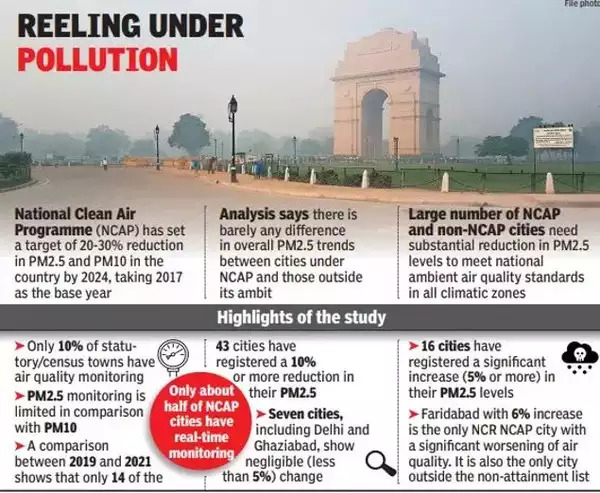ForumIAS announcing GS Foundation Program for UPSC CSE 2025-26 from 19 April. Click Here for more information.
ForumIAS Answer Writing Focus Group (AWFG) for Mains 2024 commencing from 24th June 2024. The Entrance Test for the program will be held on 28th April 2024 at 9 AM. To know more about the program visit: https://forumias.com/blog/awfg2024
Source: The post is based on the article “Delhi: How national clean air plan has failed to make a dent” published in TOI on 7th September 2022
What is the News?
An analysis by the Center for Science and Environment(CSE) has found that there is barely any difference in trends in particulate matter pollution (PM2.5) between the group of cities under the National Clean Air Programme(NCAP) and those outside its ambit.
What is the National Clean Air Programme(NCAP)?
Launched in: 2019 by the Ministry of Environment, Forests and Climate Change(MoEFCC).
Aim: To bring a 20%-30% reduction in pollution levels from PM2.5 and PM10 particles by 2024, using 2017 pollution levels as a base year.
Cities covered: The program covers 132 of India’s most polluted or so-called non-attainment cities. This is defined as a city whose air quality did not meet the national ambient air quality standards from 2011 to 2015.
Funding: Under the programme, cities are required to quantify improvement starting 2020-21, which requires a 15% and more reduction in the annual average PM10 concentration and a concurrent increase in “good air” days to at least 200. Anything fewer will be considered ‘low’ and the funding consequently reduced.
Note: For disbursing funds, the Central Pollution Control Board(CPCB) only considers levels of PM10, the relatively larger, coarser particles. However, PM2.5, the smaller, more dangerous particles, aren’t monitored as robustly in all cities mostly due to the lack of equipment.
What is the analysis of CSE on the NCAP programme?

Performance of NCAP cities on PM2.5 levels (2019-21): Only 43 NCAP cities have adequate PM 2.5 data for the period 2019-2021.Out of this, only 14 of 43 (NCAP) cities registered a 10% or more reduction in their PM2.5 levels.
– On the other hand, out of 46 non-NCAP cities with adequate data, 21 recorded significant improvement in their annual PM2.5 value with 5% or more decline between 2019 and 2021.
Only about half of NCAP cities have real-time monitoring: In 2019, only 51 out 132 NCAP cities had real-time monitoring stations. The number grew to 63 in 2021; six more NCAP cities have installed real-time monitors in 2022 so far.




